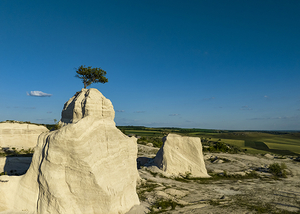Tourism
The Stâncile Prutului route represents a fascinating journey through the heart of the wild nature of the Republic of Moldova, which promises to offer you an unforgettable experience. Located in the north-east of the country, on the border with Ukraine, the Prut Rocks are impressive geological formations made up of calcareous rocks carved over millennia by the waters of the Prut River. This route offers the opportunity to explore spectacular landscapes, dense forests and rich biodiversity, while taking you along the banks of the Prut River, revealing some of the natural beauty of the Republic of Moldova. It is an ideal place for hiking, bird watching and connecting with nature in a scenic and wild environment.
The Grotto of Duruitoarea Veche
At the junction of the Ciuhur and Prut rivers, the pulse of life has been beating since the Lower Palaeolithic, when people used tools made of hewn stone. Here is the earliest monument of human history on the territory of the Republic of Moldova - Duruitoarea Veche.
Duruitoarea gorge
The Duruitoarea gorge is a geological or paleontological monument of nature. It is located in the eastern part of the village, on the left bank of the Ciuhur River, a tributary of the Prut. It covers an area of 6.63 ha.
Canyon Horodiște
The canyon with millenary rocks hides 5 larger caves (with a diameter at the entrance of 2 to 4 meters) and many others in the form of burrows with a diameter of up to 1 meter. It should be mentioned that, for a more spectacular hike and for a gradual discovery of the canyon of Horodiște, it is recommended to start from the village of Druță.
Sphinx of Horodiște
The "Sphinx of Horodiște" is a rock prominence once artificially excavated. The image of the sphinx is more attractive from the village of Druță, where you can see its outline better, but also because it forms a perfect contrast for photographs, with the west behind it.
Costesti-Stinca Dam
The Costesti-Stânca hydrotechnical node on the Prut river is one of the most beautiful, but also the most useful hydrotechnical constructions in Romania. The dam impresses not only in Moldova, but also in Europe, being the third in Europe in terms of water retention capacity and the extent of the reservoir.
The Țiglău Cliff / The Echo Grotto
At the foot of the pine forest, the rocky Țiglău Cliff rises up. With its unique acoustics, the Țiglău cliff, (the name is said to mean mountain head) has two of the most spectacular caves. One is in the perfect shape of a circle with a diameter of 4 meters at the entrance, with millennia-old fire marks on the cave's vault.
Horodistei bridges
As the whole village stretches only on the right side of the river Ciuhur, like all the villages in the perimeter of Ciuhur, the bridges are specific to the villages on Ciuhur. The only exception is the village of Druță, which is situated on the left side. This is the reason tha, in the past, Druța was called Stângăceni
Țugui's grotto
The legend says that 250 years ago, the fearless outlaw Țugui with his Turkish girlfriend Rada, in order not to fall prey to the Turks, hid in that cave or in the forest, from where it later got its name, Rada Forest. And the families of the peasants were in every way against the Ottoman yoke, so they hid in that cave
Fetești Gorge - "Little Switzerland"
Surrounded and watched over by the old guardians of the Republic of Moldova - the Prut Cliffs, is a small, hidden corner of heaven, "Moldovan Switzerland".
Druță Gorge
A walk on the bottom of the Sarmatian sea. The village is located on the left side of the gorge, intersected by the Ciuhur river, which hides in a long and very winding gorge, which over the course of more than 7 million years, managed to dig a vast valley and quite deep.
The Costești-Stânca reservoir
The Costești-Stânca reservoir is a lake with an area of 59 square km, located on the Prut river at the border between the Republic of Moldova and Romania .
Draghiște River
The hydronym Draghiște, according to the late scholar Ion Dron, is old, of Daco-Getic or old Romanian origin and passed through the Slavic lineage - draga (Bulgarian, Serbian, Slovenian), draha (Czech), droga (Polish), meaning in these foreign languages - "a strait, a gorge, a dip (in relief), a place where water drains, a valley and even a road; a path".
Ciuhur River
"Ciuhur River" is the river that flows through the village of Văratic, but has its sources near the small town of Ocnita and carries its waters on the territory of the districts of Ocnita, Edinet, Riscani. It flows into the Prut River north of Costești. Its length is 90 km.
Bison's Habitat
Near the village of Moara Domnească is the "Zimbrăria", a fenced-in forest site covering 32 ha, with 7 bison. The bison is the only species of wild animal in the bovine family that has survived to the present day.
Brînzeni Grottoes
The Brînzeni caves represent a natural monument of its kind geological or paleontological in Edineț district, Republic Moldova. They are located in the Brînzeni reefs, 13 km south-east of Brînzeni village, at the edge of the plateau on the left side of the Racovaț river; Edineț forestry bypass...
The Brînzeni Gorge
The Brînzeni Gorge is a natural monument of geological or paleontological type with an area of 44 ha. This gorge appeared 15-20 million years ago, when the Tortonian and Sarmatian seas withdrew from our lands. The gorge is composed of limestone formations, which contain particles of coral, molluscs, shells, algae and marine animals.
Trinca Gorge
The Trinca Gorge was born thousands and thousands of years ago, when the Draghiste River was relentlessly digging into the lower Badenian-Sarmatian limestone reef. Thus, the picturesque landscape was created with a deep valley, surrounded by rocky walls, steep in places. On the slopes of these great toltres are located several grottoes that shelter the past. In these grottos time has stopped, here haunts the history and memories of the ancient world, which has left us evidence of its existence - skeletal remains of hunted animals and prehistoric Neanderthal people.
The apiary and the "Land of Honey" Museum
Today the holy place - "Cuvioasa Parascheva" is enjoyed by the faithful people of the village having in its garden an apiary and a new stone church built by the landlord Caceaun in 1775. Boroseni's land of honey is a unique apiary in the north of Moldavia, where the soul is soothed with prayer and the hum of bees. "Go to the bee and see how industrious it is and what skilful work it does. Her work is used for health by kings and commoners alike. She is loved and praised by all" ( Bible parables 6,9.)
"Land of the Grey Herons"
"The Land of the Great Herons" - is a unique colony of over 1,000 wading birds nesting on oak trees. It is a part of the "Pădurea Domnească" (Royal Forest) reserve. The area of the oak forest where the Grey Herons nest is not very large - about 1 hectare.
"Pine forest"-Bulhac
"Pine forest" Bulhac On the left side of the gorge you can see the pine forest, called by the villagers, but also by the Soviet cadastral maps - Bulhac. On the top of the cliff there is probably the only karst lake in Moldova. It is of perfectly circular shape, and is located at an altitude of over 100 meters above sea level.


 ro
ro
 ru
ru

.jpg)

















